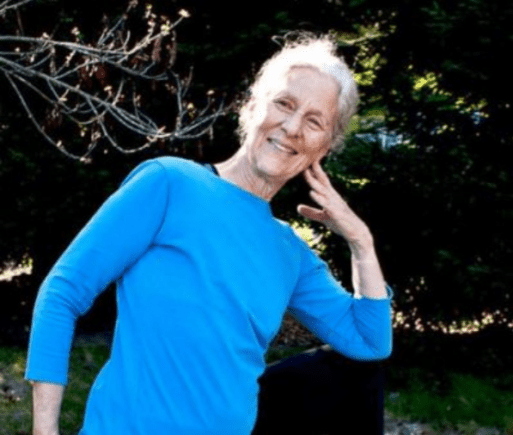
Kaethe Weingarten during a dance performance
Kaethe Weingarten, Ph.D., is keenly attuned to the pressing need for social justice. Grappling both with illness’s impact on families and with the repercussions of witnessing violence, Dr. Weingarten is dedicated to promoting what she calls “reasonable hope.”
After receiving her Ph.D. in clinical psychology from Harvard University in 1974, Dr. Weingarten went on to teach, author dozens of articles and several books, and consult with numerous organizations. Over time, Dr. Weingarten developed the witnessing model, which examines the impact of witnessing violence at a number of scales, from the biological to the social-systemic.
To support and promote the witnessing model, Dr. Weingarten founded The Witnessing Project in 2002. The following year, Dr. Weingarten published Common Shock, a book that outlines the ramifications of witnessing everyday violence. Expanding upon this work, Dr. Weingarten developed the Treatment Dedication Project, which encourages cancer patients to find empowerment by dedicating their treatment to those that inspire them.
In 2018, Dr. Weingarten became the director of the American Family Therapy Academy’s Witness to Witness program, which became sponsored by Migrant Clinicians Network in 2020. Initially developed to assist individuals working at the border, the Witness to Witness program supports people in provider positions such as healthcare workers, lawyers and advocates. Acknowledging that “the helpers need help,” Witness to Witness offers one-on-one phone calls, peer support groups, webinars, and organizational consultations. Ultimately, the program seeks to promote individual, organizational and communal resilience.
Editor’s note: This interview has been edited for length and clarity.
Emma Cohen: To begin, could you explain how critical illness impacts family systems?
Kaethe Weingarten: I am a firm believer that the disease process itself differentially shapes the impact on a family.
If someone has an illness that is well understood, they will likely have access to good treatment for it. Their family will have a different experience than, say, a family in which there is clearly something the matter with a child but nobody seems to know what it is. The dynamics become complicated then: Doctors don’t know what the treatment should be, they feel frustrated, and that frustration gets communicated to the families. Perhaps the parents feel alone and the child feels guilty. You can see how the dynamics unfold very differently in these two situations.
How do these dynamics impact caregivers?
Here is one challenge that I think is often less understood. We know that patients often experience self-loss: “I am sick, I am exhausted. I am not who I was, nor can I do what I once did.” I think what people often don’t appreciate is that the caregiver also has an experience of loss. They, too, are unable to do what they did and be who they were. And then you put the dynamics together for a couple—you are often in a situation where you’re having to develop quite a different relationship.

Kaethe Weingarten enjoys dinner with her family
Much of the work you do encourages moving from a position of disempowerment to one of empowerment. What do disempowerment and empowerment look like in the context of critical illness?
One way to illustrate this is to describe the development of the Treatment Dedication Project.
In 2003, I was diagnosed with my third breast cancer. And on December 1, which is Global AIDS Day, I attended a panel. The keynote speaker described meeting a young physician in 2000 who worked with AIDS patients in South Africa. In that era, there were no antiretroviral drugs available in South Africa. When people were admitted to the hospital, they would basically be identified as having AIDS and sent home; there was nothing that could be done for them. The keynote speaker asked this young physician how she could sustain her commitment to this often devastating work. She showed him that on her bulletin board was the speech that Robert Kennedy gave in South Africa, and she told him how inspiring the speech was for her.
I was sitting in the audience, and I was feeling pretty sorry for myself. And then I thought: I have to leave this panel to go to radiation. What if I dedicate this radiation treatment to my colleagues in South Africa? I can express to them how grateful I am that I have access to these life-saving treatments.
I had a colleague at that time who was working in Johannesburg, and she had sent me this really beautiful picture of her adopted daughter who herself had AIDS. When I went into my radiation session, I told the attendant that I wanted to have the photograph of this little girl on my belly, and that I was dedicating my treatment to her and to my colleagues in South Africa. It completely transformed my experience of my remaining treatments. Every day, I would identify an organization or a person that I wanted to honor and then I would write to them.
At one point, I asked my son, who is a journalist, who I might dedicate my treatment to in honor of him. He asked if I could honor Anthony Shadid, who at that time was covering the Iraq war. I wrote to Shadid and told him that my son and I were honoring him for his incredibly important coverage of the Iraq war. And he wrote back and said, “I got your email when I was in an ambush. I had been thinking to myself, ‘Why am I here? Does this matter to anyone?’ And your message showed me that it does matter.”
In a way, I think this was a coming together of all the parts of the witnessing work that I do.
What drew you to focus on witnessing as a subject?
For that I think we’d have to go back to my childhood. In terms of family dynamics, I definitely feel that I was in the witness position in my family. I also grew up in a very political family. My parents were investigated during the McCarthy era by the Eastland Committee. So, from a very early age I was a witness to the impact of political tyranny in this country.
Then, in my early twenties, my mother was given a terminal cancer diagnosis. And in that era, under most circumstances you did not inform the patient of her prognosis. My father let my sister and myself know that my mother had less than a year to live and that we were not to tell her. I found that extremely challenging and difficult. The experience of being a witness to my mother’s suffering and being constrained from talking with her directly about it, being in an aware but disempowered witness position, was formative for me.
I think those experiences can account not just for my interest in witnessing, but also for the two domains in which I have done the majority of the work on witnessing: one domain is in the area of illness, dying and death, and the other domain is political violence.

Kaethe stands in front of the Northern Lights
That brings us to your work with the Witness to Witness program. What are some of the challenges that your clients in the program face?
In the Witness to Witness program we consult with attorneys, journalists, healthcare professionals, and ancillary staff who are working in the field of immigration. We started during a period of time when the administration’s immigration policies shifted from being challenging to actually being cruel. On the one hand, the people we work with do the work they signed up for, which has its own challenges. But in the last three-plus years, new challenges have arisen that they wouldn’t have expected. People have to manage a toxic wider context where they find themselves unable to do what they absolutely know needs to be done. This wider context creates the circumstances for people to experience “moral distress” or possibly even “moral injury.” That’s a new area of work that the Witness to Witness project is embarking on.
I’m curious about the dual nature of witnessing in your work: On the one hand, you recognize the impact that witnessing violence or trauma can have on someone’s life. On the other hand, you acknowledge the power of witnessing other people’s experiences as part of the healing process.
I make a distinction between inadvertent witnessing, where we are not choosing it, and compassionate witnessing, which is an act of choice.
My book “Common Shock” opens with an anecdote of taking my goddaughter to a park. She’s swinging, and she sees a father smack a toddler in the face. My goddaughter said, “Kaethe, we need to stop” — she had to leave the park. That’s an example of unintentional witnessing. It exceeded her threshold: She was unable to continue to play after having witnessed an abusive act.
Let’s take another example that’s very different. I’m in line at the pharmacy and the person in front of me starts harassing the person at the checkout counter. And let’s say the sales clerk handles it very well. I’m still an inadvertent witness. Now, I can choose to ignore it and say nothing. Or I can make a decision to empower myself, to shift the experience for myself and possibly for the sales clerk. I say to the sales clerk, “You did a really nice job. You could have lashed out and you didn’t, and it was actually really impressive. I’m glad I got to see that. I hope you have a better day.” That would be choosing to be a compassionate witness.
What strategies does Witness to Witness offer for dealing with the challenges of witnessing, and for promoting compassionate witnessing?
The premise of the program is that the helpers need help. Our program offers individual work, but we also offer peer support groups and organizational consultation. We are trying to make environments more trauma-sensitive for the people who work in them, and we are also trying to build organizational resilience.
How do you build resilience? One of the ways is to help people connect with why they got into the line of work they did. What is the history of their wanting to help other people? That’s really quite different from asking, what is their self-care routine? Self-care is tremendously important, but we’re trying to help people be anchored in their actual motivation for doing the work. And we’re trying to bring reminders of that into their daily practice.
It can be difficult to listen deeply to the stories of a client’s suffering. At the same time, we’re helping people understand that there is an opportunity to be inspired by their clients’ stories. We aren’t just over-exposed to trauma; there is a possibility for what my colleague Pilar Hernandez-Wolfe calls “vicarious resilience.” And that’s very exciting.
Looking forward, what changes do you hope to see in this field?
Individually, communally, and globally, I want people to be able to live their lives with dignity and peace, and to be able to make connections that feel compassionate. I do believe that this is a moment in history in many parts of the world, not all, where some of the values I hold most dear are threatened. These are dangerous times. And it requires everybody in whatever way she can to step up to the plate. That is what I am trying to do.

 The Witnessing Project Promotes Resilience Amidst Illness and Violence
The Witnessing Project Promotes Resilience Amidst Illness and Violence


 First the Wealth Gap, Now the U.S. Has a Growing Health Gap
First the Wealth Gap, Now the U.S. Has a Growing Health Gap

 Our Annual Seven Holiday Gifts for Someone Who Is Grieving, 2024 Edition
Our Annual Seven Holiday Gifts for Someone Who Is Grieving, 2024 Edition














